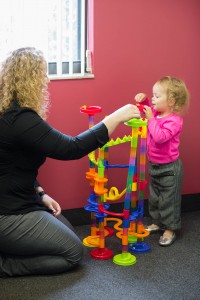
Developmental Language Milestones
 Birth to 3 months
Birth to 3 months
- startles when he or she hears loud sounds
- coos and makes pleasure sounds
- when spoken to, calms down or smiles
- recognizes your voice and quiets if crying
- has different crying sounds for various needs
- when feeding, increases or decreases sucking in response to sound
- smiles when he or she sees you
4-6 months
- moves eyes in direction of sound
- becomes aware of toys that make sounds
- pays attention to music
- reacts to changes in the tone of your voice
- babbles chains of sounds, which start to become more speech-like and contain many different sounds such as p, b, m
- giggles and laughs
- babbles when excited or unhappy
- makes different gurgling or babbling sounds when left alone and when playing with you
- responds to his or her own name
7 months to 1 year
- enjoys playing peek-a-boo and patty-cake
- turns and looks in the direction of sounds
- listens when spoken to
- understands words for common items such as “bowl”, “toy”, or “milk”
- responds to requests (“come here”)
- babbles to get and keep attention
- uses simple gestures or actions to communicate such as pulling on arm or waving goodbye
- imitates different speech sounds (“t”, “k”, “n”)
- has 1 or 2 words by first birthday (“bye”, “kitty”, “dada”, “mama”), although sounds may sound distorted or may not be clear
1-2 years
- knows and can point to a few basic body parts when asked (“arm”, “leg”, “head”)
- understands “no”
- follows simple commands and understands simple questions (“bring me your shoe”, “hug the teddy bear”, “where’s your doll?”)
- listens to simple stories, songs and rhymes
- points to pictures in a book when named
- brings objects from another room when asked
- makes familiar animal sounds
- uses up to 50 words by 2 years of age, including names
- says more words every month
- uses some one or two word questions (“where ball?” “help please?” “more juice?”)
- puts two words together (“kitty bye-bye”, “no juice”, “mommy toy”) to make wants known
- uses many different consonant sounds at the beginning of words
2 to 3 years
- understands differences in meaning (“cold-hot”, “in-out”, “big-little”, “up-down”)
- follows two step directions (“get the doll and put it on the bed”)
- listens to and enjoys stories for longer periods of time
- has a word for almost everything
- uses two or three word phrases to talk about and ask for things
- uses k, g, t, d, and n sounds
- speaks in a way that is understood by family and friends
- names objects to ask for them or to name them
- asks “why?”
- may stutter on some sounds or words
3 to 4 years
- hears you when you call from another room
- hears the radio or television at the same sound level as other family members
- understands some words for colors such as red, blue and green
- understands some words for shapes such as circle or square
- understands words for family members such as brother, grandmother and aunt
- answers simple “who?”, “what?”, “where?” and “why?” questions
- talks about activities at daycare, preschool or friends’ homes
- uses sentences with four or more words
- speaks easily without having to repeat syllables or words
- people outside the family usually understand child’s speech
- asks “when?” and “how?” questions
- uses pronouns like I, you, me, we, they
- uses some plural words such as toys, birds, and buses
4 to 5 years
- understands words for order, such as first, next and last
- understands words for time such as yesterday, today and tomorrow
- follows longer directions, like “put your pajamas on, brush your teeth and pick out a book”
- follows classroom directions like “draw a circle around something you eat”
- pays attention to a short story and answers simple questions about it
- hears and understands most of what is said at home and in school
- uses sentences that give many details
- tells stories that stay on topic
- communicates easily with other children and adults
- says most sounds correctly except for a few (l, s, r, v, z, ch, sh, and th)
- uses rhyming words
- names some letters and numbers
- uses adult grammar
- knows his or her address
- can count to 10
- understands “same” and “different”
 Birth to 3 months
Birth to 3 months
